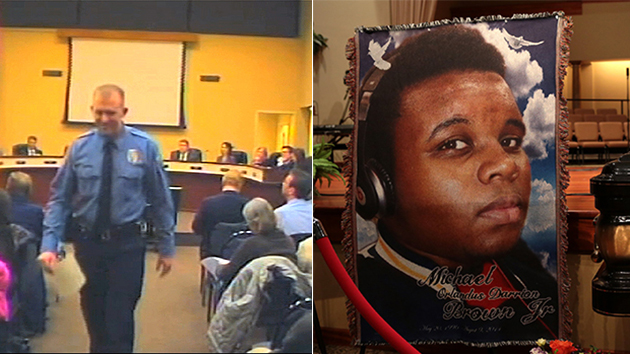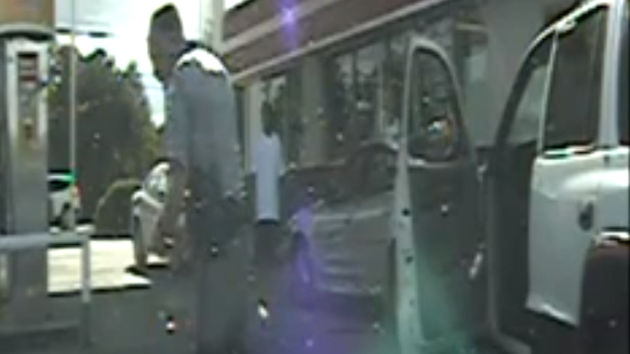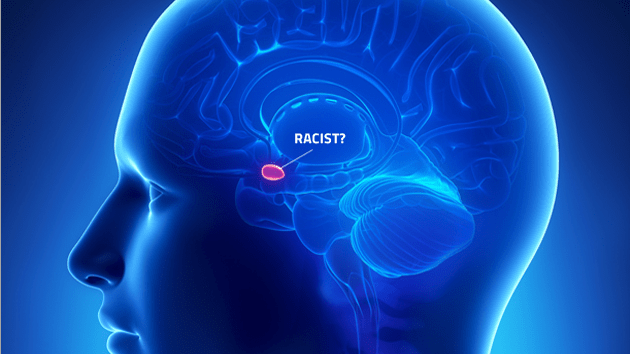
“You’re not, like, a total racist bastard,” David Amodio tells me. He pauses. “Today.”
I’m sitting in the soft-spoken cognitive neuroscientist‘s spotless office nestled within New York University’s psychology department, but it feels like I’m at the doctor’s, getting a dreaded diagnosis. On his giant monitor, Amodio shows me a big blob of data, a cluster of points depicting where people score on the Implicit Association Test. The test measures racial prejudices that we cannot consciously control. I’ve taken it three times now. This time around my uncontrolled prejudice, while clearly present, has come in significantly below the average for white people like me.
That certainly beats the first time I took the IAT online, on the website UnderstandingPrejudice.org. That time, my results showed a “strong automatic preference” for European Americans over African Americans. That was not a good thing to hear, but it’s extremely common—51 percent of online test takers show moderate to strong bias.
Taking the IAT, one of the most popular tools among researchers trying to understand racism and prejudice, is both extremely simple and pretty traumatic. The test asks you to rapidly categorize images of faces as either “African American” or “European American” while you also categorize words (like “evil,” “happy,” “awful,” and “peace”) as either “good” or “bad.” Faces and words flash on the screen, and you tap a key, as fast as you can, to indicate which category is appropriate.
Sometimes you’re asked to sort African American faces and “good” words to one side of the screen. Other times, black faces are to be sorted with “bad” words. As words and faces keep flashing by, you struggle not to make too many sorting mistakes.
And then suddenly, you have a horrible realization. When black faces and “bad” words are paired together, you feel yourself becoming faster in your categorizing—an indication that the two are more easily linked in your mind. “It’s like you’re on a bike going downhill,” Amodio says, “and you feel yourself going faster. So you can say, ‘I know this is not how I want to come off,’ but there’s no other response option.”
You think of yourself as a person who strives to be unprejudiced, but you can’t control these split-second reactions. As the milliseconds are being tallied up, you know the tale they’ll tell: When negative words and black faces are paired together, you’re a better, faster categorizer. Which suggests that racially biased messages from the culture around you have shaped the very wiring of your brain.
I went to NYU to learn what psychologists could tell me about racial prejudice in the wake of the shooting of a black teenager, Michael Brown, by a white police officer, Darren Wilson, in Ferguson, Missouri. We may never really know the exact sequence of events and assumptions that led to the moment when Brown, unarmed and, according to witnesses, with his hands in the air, was shot multiple times. But the incident is the latest embodiment of America’s racial paradox: On the one hand, overt expressions of prejudice have grown markedly less common than they were in the Archie Bunker era. We elected, and reelected, a black president. In many parts of the country, hardly anyone bats an eye at interracial relationships. Most people do not consider racial hostility acceptable. That’s why it was so shocking when Los Angeles Clippers owner Donald Sterling was caught telling his girlfriend not to bring black people to games—and why those comments led the NBA to ban Sterling for life. And yet, the killings of Michael Brown, Jordan Davis, Renisha McBride, Trayvon Martin, and so many others remind us that we are far from a prejudice-free society.
Science offers an explanation for this paradox—albeit a very uncomfortable one. An impressive body of psychological research suggests that the men who killed Brown and Martin need not have been conscious, overt racists to do what they did (though they may have been). The same goes for the crowds that flock to support the shooter each time these tragedies become public, or the birthers whose racially tinged conspiracy theories paint President Obama as a usurper. These people who voice mind-boggling opinions while swearing they’re not racist at all—they make sense to science, because the paradigm for understanding prejudice has evolved. There “doesn’t need to be intent, doesn’t need to be desire; there could even be desire in the opposite direction,” explains University of Virginia psychologist Brian Nosek, a prominent IAT researcher. “But biased results can still occur.”
The IAT is the most famous demonstration of this reality, but it’s just one of many similar tools. Through them, psychologists have chased prejudice back to its lair—the human brain.
We’re not born with racial prejudices. We may never even have been “taught” them. Rather, explains Nosek, prejudice draws on “many of the same tools that help our minds figure out what’s good and what’s bad.” In evolutionary terms, it’s efficient to quickly classify a grizzly bear as “dangerous.” The trouble comes when the brain uses similar processes to form negative views about groups of people.
But here’s the good news: Research suggests that once we understand the psychological pathways that lead to prejudice, we just might be able to train our brains to go in the opposite direction.
Dog, cat. Hot, cold. Black, white. Male, female. We constantly categorize. We have to. Sorting anything from furniture to animals to concepts into different filing folders inside our brains is something that happens automatically, and it helps us function. In fact, categorization has an evolutionary purpose: Assuming that all mushrooms are poisonous, that all lions want to eat you, is a very effective way of coping with your surroundings. Forget being nuanced about nonpoisonous mushrooms and occasionally nonhungry lions—certitude keeps you safe.
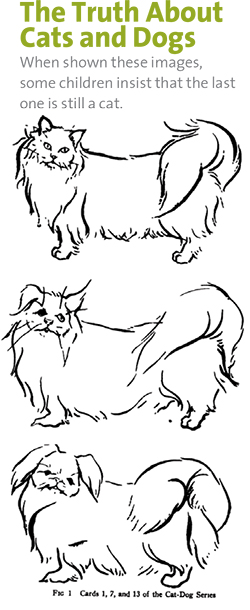
But a particular way of categorizing can be inaccurate, and those false categories can lead to prejudice and stereotyping. Much psychological research into bias has focused on how people “essentialize” certain categories, which boils down to assuming that these categories have an underlying nature that is tied to inherent and immutable qualities. Like the broader sorting mechanism of categorization, an essentialist cognitive “style” emerges very early in our development and may to some extent be hardwired. Psychologist Susan Gelman of the University of Michigan explains it this way: The category of “things that are white” is not essentialized. It simply contains anything that happens to share the attribute of “white”: cars, paint, paper, and so on. There’s nothing deep that unites the members of this category.
But now consider white and black people. Like other human attributes (gender, age, and sexual orientation, for example), race tends to be strongly—and inaccurately—essentialized. This means that when you think of people in that category, you rapidly or even automatically come up with assumptions about their characteristics—characteristics that your brain perceives as unchanging and often rooted in biology. Common stereotypes with the category “African Americans,” for example, include “loud,” “good dancers,” and “good at sports.” (One recent study found that white people also tend to essentialize African Americans as magical—test subjects associated black faces with words like “paranormal” and “spirit.”) Of course, these assumptions are false. Indeed, essentialism about any group of people is dubious—women are not innately gentle, old people are not inherently feebleminded—and when it comes to race, the idea of deep and fundamental differences has been roundly debunked by scientists.
Even people who know that essentializing race is wrong can’t help absorbing the stereotypes that are pervasive in our culture. But essentialist thinking varies greatly between individuals. It’s kind of like neurosis: We all have a little bit, but in some people, it’s much more pronounced. In national polls, for example, fewer and fewer Americans admit openly to holding racist views. But when told to rate various groups with questions like, “Do people in these groups tend to be unintelligent or tend to be intelligent?” more than half of those asked exhibited strong bias against African Americans. Even the labels we use seem to affect our level of prejudice: Another study found that test subjects associated the term “black” with more negative attributes—such as low socioeconomic status—than “African American.”
One of the earliest and most insightful researchers on these varying rates of bias was Else Frenkel-Brunswik, part of a pioneering generation of post-World War II psychologists who sought to understand why some people seem to find prejudiced and fascist ideas so appealing. Born in 1908 to a Jewish family in what is now Ukraine, Frenkel-Brunswik might never have managed to do her research at all had she not twice escaped the forces of prejudice herself. When she was young, a 1914 pogrom forced her family to flee to Vienna. When Germany annexed Austria in 1938, she sought refuge in the United States.
Frenkel-Brunswik’s work came long before the days of high-tech tools like eye trackers and computer games that measure bias based on millisecond differences between reactions. Instead she used something far simpler: cards.
She studied young children, some of whom she had previously documented to be highly prejudiced and ethnocentric. In one of many experiments, Frenkel-Brunswik showed the children a sequence of cards similar to the ones on this page. On the first card, the animal is clearly and distinctly a cat. On the last card, it is just as clearly and distinctly a dog. But in between, the cat slowly transforms into the dog.
At each of the stages, the children were asked to identify the animal on the card. Among the more prejudiced children, Frenkel-Brunswik noted something striking: As the image became increasingly ambiguous, “there was a greater reluctance to give up the original object about which one had felt relatively certain…a tendency not to see what did not harmonize with the first set as well as a shying away from transitional solutions.” In other words, for these children, it was much harder to let go of the idea that a cat was a cat.
What Frenkel-Brunswik realized back in 1949, modern research reaffirms. The Implicit Association Test, after all, boils down to how your mind automatically links certain categories. “It’s really how strongly you associate your category of ‘black people’ with the general category of ‘good things’ or ‘bad things,'” David Amodio told me. “The capacity to discern ‘us’ from ‘them’ is fundamental in the human brain,” he wrote in a 2014 paper. “Although this computation takes just a fraction of a second, it sets the stage for social categorization, stereotypes, prejudices, intergroup conflict and inequality, and, at the extremes, war and genocide.” Call it the banality of prejudice.
The process of categorizing the world obviously includes identifying the group or groups to which you belong. And that’s where the next psychological factor underpinning prejudice emerges. Much research has found that humans are tribal creatures, showing strong bias against those we perceive as different from us and favoritism toward those we perceive as similar.
In fact, we humans will divide ourselves into in-groups and out-groups even when the perceived differences between the specific groups are completely arbitrary. In one classic study, subjects are asked to rate how much they like a large series of paintings, some of which are described as belonging to the “Red” artistic school and others to the “Green” school. Then participants are sorted into two groups, red or green—not based on their favoring one school of painting, as they are made to think, but actually at random. In subsequent tasks, people consistently show favoritism toward the arbitrary color group to which they are assigned. When asked to allocate money to other participants, the majority of “reds” more generously fund other reds—despite the fact that they have never actually met them. The same goes for “greens.”
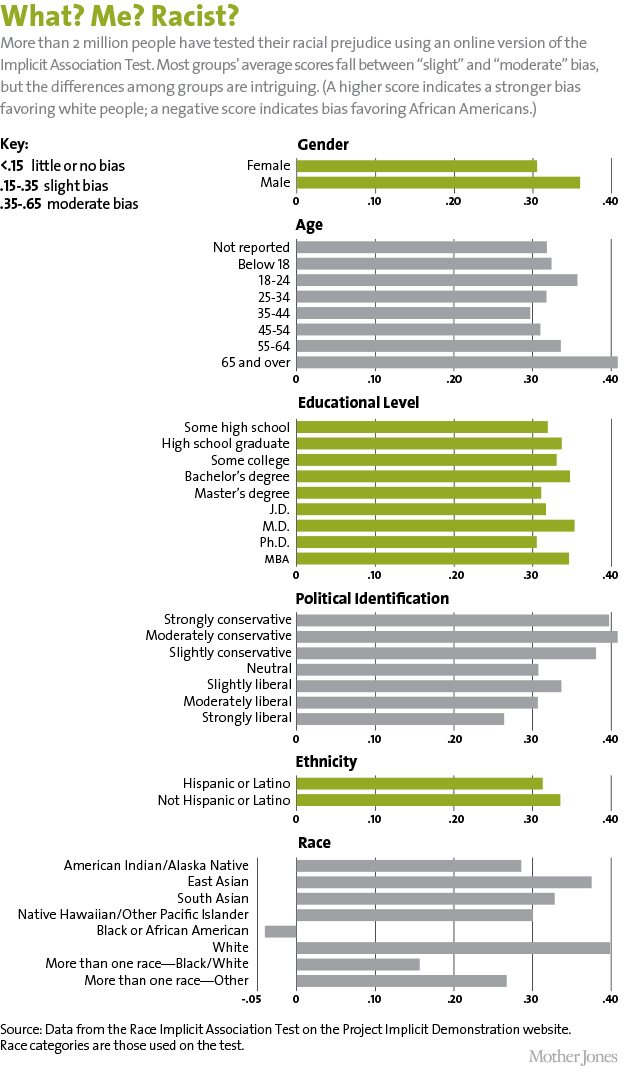
The upshot of such “minimal group” experiments is that if you give people the slightest push toward behaving tribally, they happily comply. So if race is the basis on which tribes are identified, expect serious problems.
As these experiments suggest, it is not that we are either prejudiced or unprejudiced, period. Rather, we are more and less prejudiced, based on our upbringings and experiences but also on a variety of temporary or situational prompts (like being told we’re on the green team).
One simple, evolutionary explanation for our innate tendency toward tribalism is safety in numbers. You’re more likely to survive an attack from a marauding tribe if you join forces with your buddies. And primal fear of those not in the in-group also seems closely tied to racial bias. Amodio’s research suggests that one key area associated with prejudice is the amygdala, a small and evolutionarily ancient region in the middle of the brain that is responsible for triggering the notorious “fight or flight” response. In interracial situations, Amodio explains, amygdala firing can translate into anything from “less direct eye gaze and more social distance” to literal fear and vigilance toward those of other races.
We’ve seen how a variety of cognitive behaviors feed into prejudice. But you know what will really blow your mind? The way that prejudice (or rather, the cognitive styles that underlie it) can interfere with how our brains function—often for the worse.
Consider, for instance, research by Carmit Tadmor, a psychologist at the Recanati School of Business at Tel Aviv University. In one 2013 paper, Tadmor and her colleagues showed that racial prejudice can play a direct and causal role in making people less creative. We’re not talking about artistic creativity here, but more like seeing beyond the constraints of traditional categories—”thinking outside the box.”
Tadmor’s team first uncovered a simple positive correlation between one’s inclination to endorse an essentialist view of race (like associating racial differences with abilities and personality traits) and one’s creativity. To measure the latter, the researchers used a simple open-ended test in which individuals are asked to list as many possible uses of a brick as they can think of. People who can think outside of traditional categories—realizing that a brick can be used for many things other than buildings (it can make a good paperweight, for starters)—score better. This study showed that people who essentialized racial categories tended to have fewer innovative ideas about a brick.
But that was just the beginning. Next, a new set of research subjects read essays that described race either as a fundamental difference between people (an essentialist position) or as a construct, not reflecting anything more than skin-deep differences (a nonessentialist position). After reading the essays, the subjects moved on to a difficult creativity test that requires you to identify the one key word that unites three seemingly unassociated words. Thus, for instance, if you are given the words “call,” “pay,” and “line,” the correct answer is “phone.”
Remarkably, subjects who’d read the nonessentialist essay about race fared considerably better on the creativity test. Their mean score was a full point—or 32 percent—higher than it was for those who read the essentialist essay.
It’s not like the people in this study were selected because of their preexisting racial prejudices. They weren’t. Instead, merely a temporary exposure to essentialist thinking seemed to hamper their cognitive flexibility. “Essentialism appears to exert its negative effects on creativity not through what people think but how they think,” conclude Tadmor and her colleagues. That’s because, they add, “stereotyping and creative stagnation are rooted in a similar tendency to overrely on existing category attributes.” Those quick-judgment skills that allowed us to survive on the savanna? Not always helpful in modern life.
So, yes: Prejudice and essentialism are bad for your brain—if you value creative thinking, anyway. But they can also be downright dangerous.
At NYU, David Amodio sat me down to take another test called the Weapons Identification Task. I had no idea what I was in for.
In this test, like on the IAT, you have two buttons that you can push. Images flash rapidly on the screen, and your task is to push the left shift key if you see a tool (a wrench, or a power drill, say) and the right shift key if you see a gun. You have to go super fast—if you don’t respond within half a second, the screen blares at you, in giant red letters, “TOO SLOW.”
“It does that to keep you from thinking too much,” Amodio would later explain.
But it’s not just guns and tools flashing on the screen: Before each object you see a face, either white or black. The faces appear for a split second, the objects for a split second, and then you have to press a key. If you are faster and more accurate at identifying guns after you see a black face than after you see a white face, that would suggest your brain associates guns (and threat) more with the former. You might also be more inclined to wrongly think you see a gun, when it’s actually just a tool, right after seeing a black face. (The weapons task was created by psychologist Keith Payne of the University of North Carolina-Chapel Hill in response to the tragic 1999 death of Amadou Diallo, a Guinean immigrant shot by New York City police after the officers mistook the wallet in his hand for a weapon.)
I’m sorry to ruin the suspense: I don’t know what my score was on the Weapons Identification Task. The test ruffled me so much that I messed up badly. It is stressful to have to answer quickly to avoid being rebuked by the game. And it’s even more upsetting to realize that you’ve just “seen” a gun that wasn’t actually there, right after a black face flashed.
This happened to me several times, and then I suddenly found myself getting “TOO SLOW” messages whenever the object to be identified was a gun. This went on for many minutes and numerous trials. For a while, I thought the test was broken. But it wasn’t: I finally realized that rather than pressing the right shift key, I had somehow started pressing the enter key whenever I thought I saw a gun. It’s almost like I’d subconsciously decided to stop making “gun” choices at all. (Psychoanalyze that.)
But don’t take that as a cop-out: Before I (arguably) tried to dodge responsibility by pressing the wrong key, I clearly showed implicit bias. And it was horrifying.
The upshot of all of this research is that in order to rid the world of prejudice, we can’t simply snuff out overt, conscious, full-throated racism. Nor can we fundamentally remake the human brain, with its rapid-fire associations and its categorizing, essentializing, and groupish tendencies. Instead, the key lies in shifting people’s behavior, even as we also make them aware of how cultural assumptions merge with natural cognitive processes to create biases they may not know they have.
And that just might be possible. Take the Implicit Association Test: In a massive study, Brian Nosek of the University of Virginia and his colleagues tested 17 different proposed ways of reducing people’s unconscious bias on the IAT. Many of these experimental interventions failed. But some succeeded, and there was an interesting pattern to those that did.
The single best intervention involved putting people into scenarios and mindsets in which a black person became their ally (or even saved their life) while white people were depicted as the bad guys. In this intervention, participants “read an evocative story told in second-person narrative in which a White man assaults the participant and a Black man rescues the participant.” In other words, study subjects are induced to feel as if they have been personally helped or even saved by someone from a different race. Then they took the IAT—and showed 48 percent less bias than a control group. (Note: The groups in these various studies were roughly three-fourths white; no participants were black.)

Other variations on this idea were successful too: making nonblack people think about black role models, or imagine themselves playing on a dodgeball team with black teammates against a team of white people (who proceed to cheat). In other words, it appears that our tribal instincts can actually be co-opted to decrease prejudice, if we are made to see those of other races as part of our team.
When it comes to weakening racial essentialism, Carmit Tadmor and her colleagues undertook a variety of experiments to try to produce what they called “epistemic unfreezing.” Subjects were exposed to one of three 20-minute multimedia presentations: one exclusively about American culture, one exclusively about Chinese culture, and one comparing American and Chinese cultures (with different aspects of each culture, such as architecture or food, presented back to back). Only in the last scenario were subjects pushed to compare and contrast the two cultures, presumably leading to a more nuanced perspective on their similarities and differences.
This experimental manipulation has been found to increase creativity. But surprisingly, it also had a big effect on reducing anti-black prejudice. In one study, Tadmor et al. found that white research subjects who had heard the multicultural presentation (but not the American-only or Chinese-only presentation) were less likely than members of the other study groups to endorse stereotypes about African Americans. That was true even though the subjects had learned about Chinese and American cultures, not African American culture.
In a variation, the same 20-minute lecture also produced fewer discriminatory hiring decisions. After hearing one of the three kinds of lectures, white study subjects were shown a series of résumés for the position of “Sales Manager” at a company. The résumés were varied so that some applicants had white-sounding names, and some had black-sounding names. It’s a research paradigm that has often been shown to produce discriminatory effects, which presumably occur through the manifestation of uncontrolled or implicit prejudices—but this time around, there was a glimmer of hope in the findings.
White subjects who had heard the lecture exclusively about American culture (with topics like Disney, Coca-Cola, and the White House) picked a white candidate over an equally qualified black candidate 81 percent of the time. Subjects who had heard a lecture exclusively about Chinese culture picked a white candidate a full 86 percent of the time. But subjects who had heard the culture-comparing lecture selected the white candidate only 56 percent of the time.
These studies clearly suggest that, at least for the relatively short time span of a psychology experiment, there are cognitive ways to make people less prejudiced. That’s not the same as—nor can it be a substitute for—broader cultural or institutional change. After all, there is ample evidence that culture feeds directly into the mind’s process of generating prejudices and adopting stereotypical beliefs.
Nonetheless, if prejudice has both a psychological side and a cultural side, we must address both of these aspects. A good start may simply be making people aware of just how unconsciously biased they can be. That’s particularly critical in law enforcement, where implicit biases can lead to tragic outcomes.
In fact, this phenomenon has been directly studied in the lab, particularly through first-person shooter tests, where subjects must rapidly decide whether to shoot individuals holding either guns or harmless objects like wallets and soda cans. Research suggests that police officers (those studied were mostly white) are much more accurate at the general task (not shooting unarmed people) than civilians, thanks to their training. But like civilians, police are considerably slower to press the “don’t shoot” button for an unarmed black man than they are for an unarmed white man—and faster to shoot an armed black man than an armed white man. (Women weren’t included—the extra variable of gender would have complicated the results.)
Such research has led to initiatives like the Fair and Impartial Policing program, which has trained officers across the United States on how implicit biases work and how to control them. Few officers look forward to these trainings, says program founder Lorie Fridell, a criminologist; they don’t consider themselves to be racist. “Police are very defensive about this issue,” she says. “That’s because we have been dealing with this issue using outdated science. We treat them as if they have an explicit bias. They are offended by that.”
So instead, Fridell’s team focuses first on showing the officers the subtle ways in which implicit bias might influence their actions. For example: The trainers present a role-play where there are three people: a female victim of domestic violence, and a male and female comforting her. When the officers are asked to address the situation, says Fridell, most assume that the man is the perp. Then, the trainers reveal that it was actually the woman—and the officers learn that they do, in fact, act on bias. It’s not because they are bad people; in fact, in their work, they may have experiences that reinforce stereotypes. Which is why it’s important that police officers—who see the worst in people in their everyday duties—teach themselves not to assume the worst.
The program, which receives support from the US Department of Justice, has trained officers in more than 250 precincts and agencies, but it’s hard to measure its success—there is no baseline comparison, since prejudiced policing isn’t always rigorously documented. But the feedback is encouraging. “I have a new awareness of bias-based policing within my own agency,” one participant wrote in an evaluation. “The presentation of scientific data provided me with a more convincing argument that supported the existence of unintentional, but widespread racial bias, which I was typically quick to dismiss.”
Staff members at the University of California-Los Angeles-based Center for Policing Equity use implicit-bias research in a different way: They take unconscious prejudice as a given—and try to make changes within communities to ensure that it does as little damage as possible. A few years ago, Las Vegas was seeking to address police officers’ use of force, especially against people of color. Most of the incidents occurred after pursuits of suspects on foot, the majority of which happened in nonwhite neighborhoods. Center president Phillip Atiba Goff explains that he knew how difficult it would be to change the pursuing officers’ thinking. “You’re an officer, you’re pumping adrenaline, you don’t have time to evaluate whether your implicit bias is driving your behavior,” he says. So instead, the center worked with the department to make a small but meaningful tweak to the rules: In foot chases, the pursuing officer would no longer be allowed to touch the person being chased; if use of force was necessary, a partner who wasn’t involved in the pursuit would step in. “We recognized implicit bias, and we took it out of the equation,” Goff says. “We decoupled the prejudice from the behavior.” Sure enough, use of force in foot chases—and, as a result, overall use of force against people of color—declined significantly shortly after the policy went into effect.
Unsettling though it is, the latest research on our brains could actually have some very positive outcomes—if we use it in the right way. The link between essentialism and creativity doesn’t just tell us how we might reduce prejudice. It could also help us to become a more innovative country—by prioritizing diversity, and the cognitive complexity and boost in creativity it entails. The research on rapid-fire, implicit biases, meanwhile, should restart a debate over the role of media—the news segment that depicts immigrants as hostile job snatchers, the misogynistic lyrics in a song—in subtly imparting stereotypes that literally affect brain wiring. Indeed, you could argue that not only does the culture in which we live make us subtly prejudiced, but it does so against our will. That’s a disturbing thought.
Especially when you consider how biases affect government policy. Consider this: In October 2012, researchers from the University of Southern California sent emails asking legislators in districts with large Latino populations what documentation was needed in order to vote. Half the emails came from people with Anglo-sounding names; the other half, Latino-sounding names. Republican politicians who had sponsored voter ID laws responded to 27 percent of emails from “Latino” constituents and 67 percent of emails from “white” constituents. For Republicans who’d voted against voter ID laws, the gap was far less dramatic—the response figures were 38 percent for Latino names and 54 percent for white names.
You can imagine how this kind of thing might create a vicious cycle: When biased legislators make it harder for certain communities to vote, they are also less likely to serve alongside lawmakers from those communities—thus making it less likely for a coalitional experience to change their biases.
So how do we break the cycle? We could require lawmakers to engage in exercises to recognize their own unconscious prejudice, like the Fair and Impartial Policing program does. Or we could even go a step further and anonymize emails they receive from constituents—thus taking implicit bias out of the equation.
Short of that, you can do something very simple to fight prejudice: Trick your brain. UNC-Chapel Hill’s Payne suggests that by deliberately thinking a thought that is directly counter to widespread stereotypes, you can break normal patterns of association. What counts as counterstereotypical? Well, Payne’s study found that when research subjects were instructed to think the word “safe” whenever they saw a black face—undermining the stereotypical association between black people and danger—they were 10 percent less likely than those in a control group to misidentify a gun in the Weapons Identification Task.
To be sure, it will take more than thought exercises to erase the deep tracks of prejudice America has carved through the generations. But consciousness and awareness are a start—and the psychological research is nothing if not a consciousness-raiser. Taking the IAT made me realize that we can’t just draw some arbitrary line between prejudiced people and unprejudiced people, and declare ourselves to be on the side of the angels. Biases have slipped into all of our brains. And that means we all have a responsibility to recognize those biases—and work to change them.
